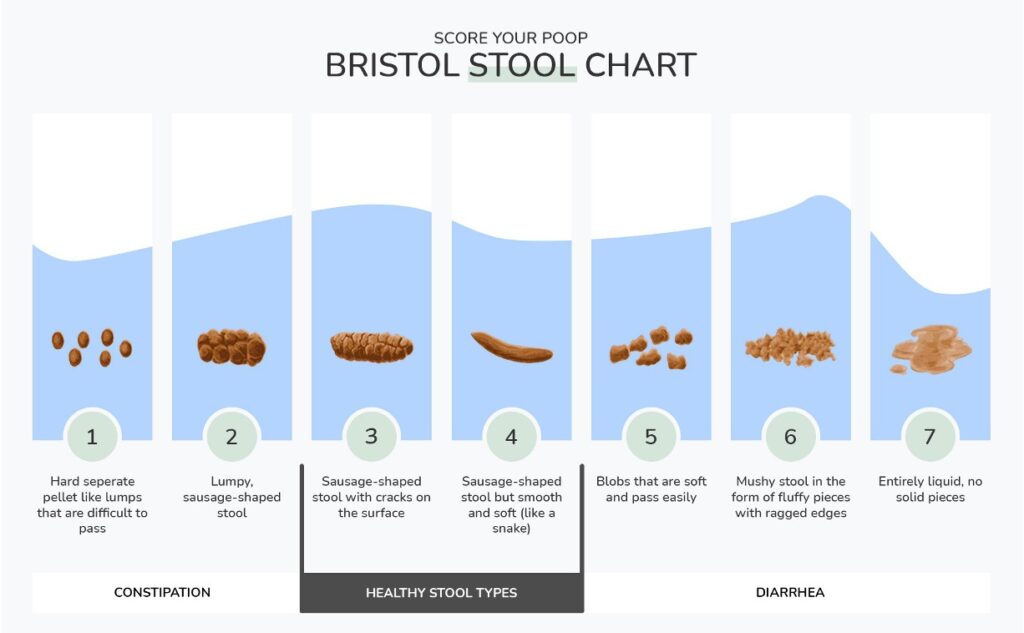Intro
In our day-to-day lives, we often overlook the simple acts and routines that can tell us the most about our health. One such overlooked aspect is our bowel movements. Yes, you read that right – poop. While it may not be a topic of polite conversation at dinner parties, understanding what your poop says about your health is crucial. Everybody poops, but not everyone talks about it.
By sidelining discussions on this natural process, we might be ignoring vital signs from our bodies. From color and consistency to frequency and smell, your bowel movements are a silent messenger, conveying critical information about your overall health.
The Basics of Bowel Movements
Understanding the basics of bowel movements is essential for interpreting the messages your body sends through poop. A healthy bowel movement typically appears smooth and soft, maintaining a single long shape without being overly hard or too liquid.
The wide range in bowel movement frequency considered normal – from three times daily to three times weekly – is influenced by individual factors such as diet, lifestyle, and personal body rhythms. The characteristics of your stool, including its consistency, frequency, color, and odor, can provide valuable insights into your health status. For instance, the consistency of your stool is a key indicator of digestive health, with certain types suggesting the need for dietary adjustments.
Similarly, changes in the frequency of bowel movements might point to underlying health conditions or dietary issues. Recognizing what is typical for you and noting any significant deviations in these aspects can help in identifying potential health concerns early. Paying attention to these details encourages proactive management of your digestive health, ensuring you can address any issues with appropriate dietary or lifestyle changes, or seek medical advice when necessary.
What Color Can Tell You About Your Health
The hues of your stool are more than just shades; they're insights into your body's internal processes. A typical brown color results from bile's interaction during digestion, serving as a baseline for healthy bowel movements. Deviations from this norm offer clues about potential health issues. Bright green stools, for instance, could reflect a diet heavy in leafy vegetables or food coloring, but they might also suggest that food isn't spending enough time being digested. This rapid transit could deprive your body of essential nutrients.
Darker colors warrant a closer examination. Stools that are black or tarry could indicate bleeding in the upper gastrointestinal tract, such as the stomach or small intestines, and necessitate immediate medical consultation. Reddish hues might not always stem from diet (such as beets); they could also point to bleeding in the lower digestive tract. Conversely, light-colored or clay-hued stools may signal a bile duct obstruction or problems with liver function, hinting at issues that could affect digestion and absorption significantly.
Each color variation provides a vital clue to understanding our body's current state, underscoring the importance of paying attention to even seemingly minor changes. Monitoring these variations can serve as a preemptive check, guiding us when to seek further evaluation or adjust our dietary habits to maintain or restore digestive health.
Deciphering the Message from Poop Consistency

The consistency of your stool offers a window into the state of your digestive health, and understanding its variations can help in maintaining or improving your wellbeing.
The Bristol Stool Chart, a diagnostic tool, classifies fecal matter into seven types, each indicating different things about your digestive system. Types 1 and 2 are on the harder side, resembling nuts or lumpy sausages, suggesting a lack of fiber and hydration in your diet. This can often lead to constipation, indicating that incorporating more water and fiber-rich foods might be beneficial.
On the other end of the spectrum, Types 5 through 7 lean towards a more liquid consistency, pointing to possible dietary intolerance or infections that could be upsetting the digestive tract. These types might necessitate a review of your diet or a consultation with a healthcare provider to identify and mitigate potential irritants or underlying conditions. Ideally, your aim should be for Types 3 and 4, which represent a smooth, soft consistency, indicating a well-functioning digestive system. Regularly achieving this consistency is a positive sign of good digestive health and suggests that your body is efficiently processing and absorbing nutrients from your diet. By keeping an eye on the consistency of your bowel movements, you can gain insights into your dietary needs and make adjustments to support your digestive health.
Frequency and What It Means for Your Gut
The rhythm of your bowel movements serves as a personal metronome for digestive health, with each deviation from your norm potentially signaling a deeper issue. A sudden increase in the number of trips to the bathroom could be an alert to conditions such as Irritable Bowel Syndrome (IBS) or an indication of hyperthyroidism.
Conversely, finding yourself less frequently engaged in bowel movements might point towards a fiber-deficient diet or hypothyroidism. It's important to note that these changes are not merely about the number of visits but also about the experience and outcome of each. Pain, discomfort, or a feeling of incomplete evacuation during these episodes can further hint at the need for a medical evaluation.
Recognizing these shifts is crucial; they are often the first sign that something within your diet or body may not be functioning as it should. While occasional fluctuations are normal, consistent changes in bowel movement frequency deserve attention. They are not just numbers but are reflective of the complex interplay between our diet, lifestyle, and the health of our digestive system. Understanding this aspect of your bowel health can guide you to make necessary adjustments or seek professional advice, ensuring your digestive tract remains as harmonious as possible.
Smell and What It Reveals

Odor emanating from bowel movements, while naturally unpleasant, can offer significant insights into your internal health. An exceptionally offensive smell, more so than usual, can signal digestive disturbances or health issues that warrant further attention. For instance, conditions that affect the body's ability to properly absorb nutrients, such as Celiac disease, can result in notably bad-smelling stool.
Additionally, your diet plays a considerable role in the scent of your poop. Consuming foods high in sulfur, like garlic, onions, and certain types of meat, can intensify the odor, making it more pungent. It's crucial to consider these factors when noticing changes in stool smell, as they could be indicative of dietary imbalances or health concerns needing to be addressed. While it might be tempting to dismiss changes in smell as diet-related, persistent odor changes, especially when accompanied by variations in stool appearance or consistency, should not be overlooked. These changes can be crucial indicators of your body's health status, emphasizing the importance of monitoring and understanding the full spectrum of signals your bowel movements provide.
Listening to Your Body's Silent Messages
Your body communicates in myriad ways, often through signals easily overlooked in the hustle and bustle of everyday life. Among these, changes in your bowel movements are significant yet frequently ignored indicators of your health status. Observing and responding to these signs can avert minor discomforts from escalating into severe health issues. Implementing a habit of tracking your bowel movements might strike some as unconventional; however, this practice can be exceptionally revealing.
By maintaining a detailed record of the nature, frequency, and characteristics of your stools, you create a valuable log that can illuminate patterns or shifts over time. This documentation becomes particularly crucial when visiting a healthcare provider, offering a comprehensive snapshot of your digestive health that can aid in diagnosis and treatment planning. Recognizing variations in your bowel movements and understanding their implications is not just about vigilance—it's about cultivating a deeper connection with your body's natural rhythms and signals. Engaging in this level of self-awareness enables you to take proactive steps toward maintaining optimal health and wellbeing, making it essential to tune into these silent messages and respond with appropriate care and attention.
The Role of Diet and Lifestyle in Healthy Digestion
Your digestive health significantly benefits from a thoughtful approach to diet and lifestyle choices. Emphasizing a diet rich in dietary fiber plays a pivotal role, as it aids in smoothing the digestive process and contributes to the formation of regular, healthy stools. This fiber can be sourced from an array of fruits, vegetables, and whole grains, each serving as a building block for a robust digestive system. Beyond the plate, hydration stands as a cornerstone of digestive wellness. Drinking ample water throughout the day facilitates the movement of waste through your intestines, reducing the risk of constipation and encouraging a more fluid digestive flow.
Engagement in regular physical activity further complements a fiber-rich diet and adequate hydration by stimulating intestinal movements, which is essential for the propulsion of food through the digestive tract. Meanwhile, effective stress management can mitigate the negative impact stress exerts on digestion, preventing stress-induced gastrointestinal issues like bloating and irregularity.
While these practices form the foundation of digestive health, it's vital to remain attentive to your body's responses to dietary and lifestyle adjustments. Variations in digestive patterns, even with a seemingly ideal regimen, underscore the importance of adapting to your body's unique needs and, when necessary, seeking professional guidance to address any persisting digestive concerns.






